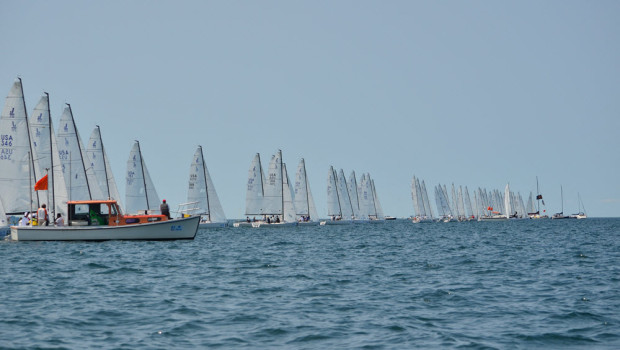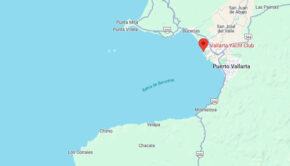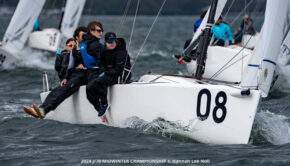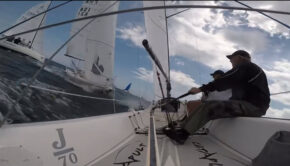Playing the Game without a Discard
Published on September 1st, 2014
When 71 teams competed in the 2014 J/70 North Americans, they had to contend with mostly light winds and a scoring format that did not utilize a throw-out race. Winning the event was Tim Healy and his team of John Mollicone, Gordon Borges and Geoff Becker, with Becker explaining how these variables impacted their approach to the series….
Tactics
A no throw-out event is certainly a large consideration when we make any of our strategic planning. In the NAC this year, there were several races when we had opportunities to take a strong position to one side upwind, which would have likely given us a lead. In nearly every instance, we chose to cross the majority of the fleet earlier than other boats, to limit our risk if the shift became unfavorable. This made our tactics, and ultimately scores, seem less flashy, but we were able to keep our boat near the front of every race in the regatta.
Starting Plan
As for the start, I have the same answer. We tried to start in a position that positioned us heading toward the part of the course we felt was likely to be favorable, while at the same time trying to limit our risk if the outcome was less favorable. In nearly every race, we found that starting near the mid-line boat worked well since it gave us a more centered position early after the start. In many races, boats that started near an extreme end of the line would hit the first shift and be clearly ahead on the first leg. Normally that is only a handful of boats, from only one side of the line, and our more centered position allowed us to be close enough to either side to stay connected to the lead group no matter which side that was.
Discard Opinion
My thoughts on a throw-out race are simple…40 boats or less, there is no need for a throw-out race and if there are 50+ boats in the fleet however, I feel that a throw-out race should be considered. A fleet with 40 boats has a starting line and course that is somewhat manageable from a tactical standpoint. The talented and faster boats seem to find the front and generally all have good finishes. When the fleet grows to more than 50 boats, the starting line is larger and the course separation and leverage becomes more difficult to manage race to race. Because of that, there are likely to be situations every boat faces that are make or break for the regatta. It is always hard to take, or even to watch, a team sail seven great races in a 50+ boat fleet and lose because of one mistake or unfortunate windshift in an eighth race.
Source: J/70 Class Newsletter









 We’ll keep your information safe.
We’ll keep your information safe.